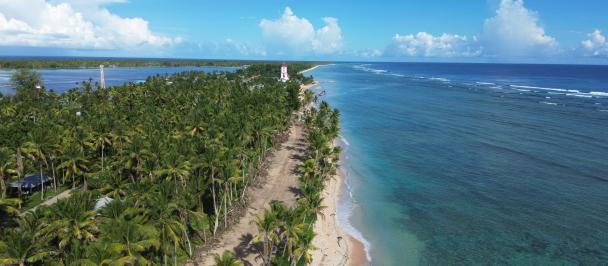WEATHERING THE STORM – BUILDING RESILIENT COMMUNITIES
June 30, 2022
Deepening of the Loimata o Apaula river around Lalovaea and building rock walls to stabilize the riverbanks - all done under the EWACC Project
On 13 December 2012, the Samoa Meteorological Services issued a special weather bulletin, including a storm warning, cyclone watch and flood advisory that Samoans would remember for years to come. A tropical depression formed in South Pacific which was later named as Cyclone Evan hit the islands of Tonga, Fiji, Samoa and the French territories of Wallis and Futuna. Illustrating a typical example of a natural hazard that turned into a disaster, the cyclone resulted in the loss of five lives, displacement of 7,500 people and damage to over 2,000 houses in Samoa. Access to electricity, water, and communication was disrupted. Buildings and roads were severely damaged. Trees and crops destroyed. All this adding up to a loss of approximately 60 million Samoan Tala (24 million US Dollars) in value.
The small island nation was slowly recovering from the devastating effects of the 2009 Tsunami for almost all progress to be reversed in less than a day. Against the backdrop of recurring cyclones, tsunami, dry-spells and earthquakes, the socio-economic development of Samoa is at high risk, necessitating strategic and effective climate change adaptation and disaster risk management interventions.
The Economic-Wide Adaptation to Climate Change (EWACC), a project funded by Global Environment Facility (GEF) and implemented by the Ministry of Natural Resources & Environment of the Government of Samoa in partnership with United Nations Development Programme (UNDP), sought to address the challenging climate vulnerabilities faced by Samoa. The project aimed to increase the economy-wide resilience of Samoa to climate- related hazards and disasters by focusing on integrating climate change adaptation and disaster risk management into national policies and development plans; enhancing resilience of communities as first responders of climate change-induced hazards; and developing a monitoring and evaluation system as well as a knowledge management strategy for effective climate and disaster risk management.
TOWARDS STRENGTHEND NATIONAL CAPACITY FOR CLIMATE CHANGE ADAPTATION
While the devastation of Cyclone Evan was profound, lessons to be learnt were many. It exposed many gaps in the current system as it swept across Samoa sounding the alarm for climate action and to build forward better. At the time, the national capacity to manage risks posed by climate-induced natural disasters was limited. Planning and implementing initiatives for climate change adaptation and disaster risk management were fragmented.
By adopting an economy-wide approach, the EWACC project contributed to enhanced institutional capacity to effectively coordinate cross-sectoral actions for climate change adaptation. A key achievement in this regard was the establishment of the new Climate Change and GEF Division within the Ministry of Natural Resources and Environment between 2018-2019. Climate change and disaster risk management is also an integral part of all national development plans and main sectoral plans at present with a National Climate Change Adaptation Strategy in the works. Furthermore, government platforms are now used increasingly to align climate-related projects and to facilitate more climate change financing.
TOWARDS RESILIENT COMMUNITIES AGAINST CLIMATE CHANGE
Cyclone Evan caused the flooding of many rivers, including the Vaisigano River, necessitating the evacuation of local communities and resulting in considerable damage to assets and infrastructure both at national and household level. With loss of assets and livelihoods, communities were left with limited capacity to recover. While the national Disaster Management Programme had developed some Village Disaster Risk Management Plans (VDRMPs) for disaster risk reduction and response, the majority of the 300 villages in the country are yet to develop and implement local-level plans. This leaves village communities increasingly vulnerable to any future climate disasters, with Samoa continuing to be extremely vulnerable to climate induced natural disasters.
Climate vulnerabilities are predicted to worsen with time if the world continues with business as usual. However, as a result of the EWACC project, island communities are more resilient and better equipped to be first responders in the face of climate change induced hazards today than they were about a decade ago. The project supported the completion of Disaster Risk Management Plans for 50 villages and Integrated Water Management Plans for urban Apia. This was complemented by the introduction of climate resilient flood protection measures in the Vaisigano River catchment. Work is also in process to improve flood management and climate change adaptation in river catchments including Gasegase, Fuluasou and Loimata o Apaula.
A total of 42,000 people enjoyed the benefits of these interventions set to protect the community assets. Communities were supported to diversify livelihoods and increase income-generating opportunities through the Small Business initiative. Approximately 384 women and 256 men, amongst which 200 were youth, benefitted from increased income owing to more secure access to livelihood assets. With more financial resources that can now be invested in climate-resilience and used for post- disaster recovery, respective households’ capacity to cope with and adapt to climate change has significantly improved. In this way, through the establishment of microenterprises and diversification, the vulnerability of more than 640 families to climate induced disasters has been reduced.
WAY FORWARD
The economy-wide adaptation to climate change interventions employed over the past eight years since 2014, has resulted in significant strides towards a more sustainable and resilient nation. Nonetheless, the work does not end here. Climate change is expected to further magnify the existing inequalities and vulnerabilities. While the effects of climate change are being felt by all, it is felt disproportionately more by the most vulnerable in society. As with most crises, vulnerable groups such as women, youth and persons with disability, will be in the frontline of the climate crisis and will suffer the most and worst in the face of consequent climate-induced disasters.
With the climate emergency now a lived reality especially for small island nations such as Samoa, we need to continue with immediate, effective, and inclusive climate action geared towards sustainability and resilience now more than ever.
UNDP SamoaFathimath Yumnu

 Locations
Locations



